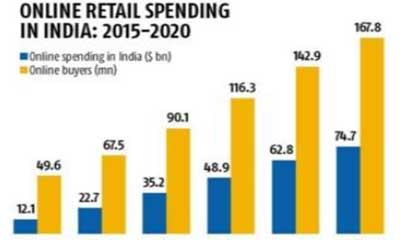GS 3 - Resources, Growth , Development , Employment
Keywords- Jobless growth, E-commerce , Gig Economy, Informalisation of economy , social security , Blue collar vs white collar
Why in News?
Recently, during Trade Policy Forum, various issues regarding e- commerce was discussed. One of them was e-commerce contribution in job creation.
What does E-commerce mean ?
An E-commerce is a commercial transaction which takes over the internet. Online stores like Amazon, Flipkart, Myntra, Quikr, Olx are examples of E-commerce websites. By 2020, global retail e-commerce reached up to $27 Trillion.
Facts regarding E-commerce:
-
The e-commerce market in India is projected to grow upto $200 billion by 2026 from $46.2 billion in 2020.
-
Online retail sales in India are expected to grow 31 per cent in the same period, to touch $32.70 billion.
-
As of August 2021, the number of internet connections in India stood at around 760 million, which further are propelling E-commerce transactions.
-
Inter-bank connectivity facilitated by the UPI offer further acceleration to e-commerce transactions.
-
Covid‐19 acted as ‘blessings in disguise’ for e-commerce expansion both in Businesses to Businesses and Business to Customers sectors.
E-commerce and Job creation:
-
Increasing demand for e-commerce transactions propelling growth in various sectors. e.g., E-commerce companies in India reported sales of $4.1 billion across platforms in the festival season of October 2021
-
Policy support of government by allowing 100 per cent FDI in B2B E-commerce, and also 100% in the automatic route in the marketplace e-commerce model further propelling E-commerce growth.
-
Increasing investments in E-commerce and internet-based companies. e.g., Net Investment of around $4.32 billion in last few years.
-
Exponentially Increasing online shopping demand in Tier-2 and Tier-3 cities. e.g., Of the total sales in 2021, 55 per cent was generated from tier-II and tier-III cities
-
New opportunities for cottage industries and entrepreneurs, this is creating an inclusive job ecosystem for both highly qualified and skilled professionals as well as those with minimal qualifications.
-
The e-commerce industry has directly impacting micro, small and medium enterprises (MSMEs) by providing means of financing, technology and training.
CASE STUDY OF Uttar Pradesh: Flipkart partner with the UP government in One District One Product Scheme and sold around 2 crore products, worth rupees 1000 crore in fiscal year 2020-21.
-
New investment in logistics and warehousing, creating further jobs, moreover the requirement of user analytics, data mining and cybersecurity functions, data scientists, supply chain managers, delivery persons, customer service are expanding Indian GIG Economy very exponentially.
-
E-commerce is also generating growth in allied industries like fintech, marketing and advertising amongst others. This had a significant impact on entrepreneurship and start-up culture and is helping handicraft workers, artisans, and women to earn a good livelihood.
Way Forward
-
The Indian e-commerce industry has been on an upward growth trajectory and is expected to surpass the US to become the second largest e-commerce market in the world by 2034.
-
The growth in the e-commerce sector will boost employment, increase revenues from exports, increase tax collection by exchequers, and provide better products and services to customers in the long-term.
-
Smartphone usage is expected to rise 84 per cent to reach 859 million by 2022. The e-retail market is expected to continue its strong growth -it registered a CAGR of over 35 per cent to reach ₹1.8 trillion.
-
Over the next five years, the Indian e-retail industry is projected to be around 350 million shoppers, propelling the online gross merchandise value to $100-120 billion by 2026.
Prelims Question
Q. Consider the following statements regarding E- commerce:
-
100% FDI allowed in inventory based model e-commerce in India.
-
E-commerce revenue growth is in increasing trend in last Five years in India.
Choose the correct statement
a. 1 only
b. 2 only
c. Both 1 and 2
d. Neither 1 nor 2
Answer: b
Mains Question
Q "The E-commerce growth in India is driven by Triple-Effect of UPI interoperability, Urban Consumerism and Start-up Boom". Comment.( 15 Marks)
Sources: The Business line









